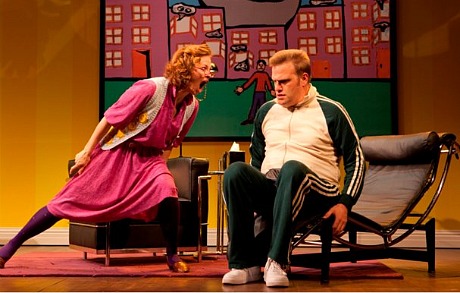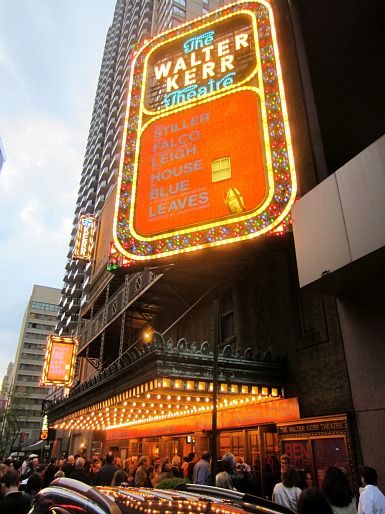Daily
The Trip
Not to sound a disrespectful note but on a certain level this trailer for Michael Winterbottom‘s The Trip (IFC Films, theatres 6.10, On Demand 6.22) is a greater achievement than the film itself, which is mildly funny and actually rather good in a steady and confident and unforced way. But the trailer is funnier…sorry.
Rob Brydon‘s Woody Allen is perfect save for the fact he doesn’t sound like him. “I want a room with a view…I want to see a tree.”
The Searchers
An HE reader is looking for copies of Memphis (Paul Greengrass‘s draft), The Girl with the Dragon Tattoo, Lord of Salem, Triple Frontier, Rock of Ages, Dark Shadows, Aryan Papers, Wartime Lies, 20000 Leagues Under the Sea (Scott Burns), The Reincarnation of Peter Proud, Lincoln (Tony Kushner draft only), The Talking Cure (a.k.a A Dangerous Method), Ant-Man (Edgar Wright) and War Horse. So am I. Anyone?
This guy has copies-to-trade of Cogan’s Trade, Cosmopolis (David Cronenberg), Moonrise Kingdom (Wes Anderson), Silence (Jay Cocks/Scorsese), The Last Photograph, Moneyball (latest draft by Zaillian and Sorkin), Drive, The Invention of Hugo Cabret, The Irishman (Steven Zaillian/Scorsese), Tinker Tailor Soldier Spy (Peter Morgan), Django Unchained, The Master (Paul Thomas Anderson), Down by Law (Jim Jarmusch), Ace in the Hole (David Mamet draft), Four Queens (David Mamet), Ordinary Daylight (David Mamet), Charlie Chan in Horse and Rider (David Mamet), Autobiography of Malcolm X (David Mamet), Hunger (Steve McQueen), Shame (Steve McQueen), Dino (Nicholas Pileggi/Scorsese), Twilight Zones (David Chase), Getting Out (Sidney Lumet), Godless (Scott Frank), A Walk Among the Tombstones (two drafts by Scott Frank), Knockout (Soderbergh), Peach Trees aka Dredd (Alex Garland), Tree of Life (Terrence Malick), 36 aka Animals (Richard Price), Wolf of Wall Street (Scorsese), Curveball (Steven Knight), Cloud Atlas (Wachowski Bros/Tykwer draft), Confederacy of Dunces (Steven Soderbergh), Don’t Be Afraid of the Dark, Gambit (Coen Bros.), Cuba Libre (Coen Bros.), God of Carnage (Roman Polanski), Hoover (Dustin Lance Black/Clint Eastwood),Lone Ranger (Ted Elliott/Terry Rossio), Rosenthaler Suite (Wes Anderson), 77 (James Ellroy), Trial of the Chicago 7 (Aaron Sorkin), We Need To Talk About Kevin (Lynne Ramsay), Young Adult (Diablo Cody) and Wettest County in the World (John Hillcoat).
Double Dose
I had a Chrissie Hynde/Pretenders/”My City Was Gone” moment last night when I caught a ghastly, bad-LSD-trip performance of Christopher Durang‘s Beyond Therapy at the “renovated” Westport Country Playhouse. The awfulness of the play induced only brief nausea spasms and isn’t worth ripping into at length, but the destruction and erasure of the old Playhouse is permanent and sickening — an act of high aesthetic criminality.

The “real” Playhouse began as a tanning factory in the early 1800s. It was transformed into a community theatre in 1930 or ’31. When I first knew it in the mid ’70s the original theatre was full of ghosts. Hundreds of serious, world-class actors had performed there for several decades, and the place had historical aroma and a certain creaky-rickety charm. The musty scent alone was enough to transport and turn on. It was “out of the past” and then some, recognized as an historic building by the State of Connecticut, etc.
And then came the nouveau riche pod-people renovation of ’03 to ’05, which cost in the neighborhood of $30 million. And in one fell swoop everything that was old and storied and musty and cherished about the place was destroyed.
The last time I checked the definition of “renovate” meant “to restore to good condition …as if new again; repair, reinvigorate, revive.” As far as I can tell the six-year-old Body Snatchers renovation was an act of obliteration. Nearly every last stick of original timber was taken away and replaced with an iron structure and freshly cut wood and coats of paint and varnish.
There might be a few remnants left over from the old Playhouse, but only on a token or fragmentary basis. (A portion of the old barn’s exterior?) Because for all practical purposes the atmosphere of the past has been completely raped and removed.
Imagine a developer tearing down an 18th Century colonial that General Cornwallis stayed in during the Revolutionary War and building a brand-new DisneyWorld replica with a few additions (state-of-the-art gym, indoor pool, a multi-media entertainment room, a six-car garage). That’s more or less what’s been done to the Westport Country Playhouse.
The adjacent Players Tavern, which had plenty of history in and of itself, has been destroyed also and replaced with the kind of tastefully soulless restaurant you might find in any upscale Midwestern city.

Imagine what an enterprising developer could do for the Roman Collisseum. Imagine the potential revenue from installing new cushioned seats and fixing up the ancient floor and staging all-new 21st Century gladiator battles, etc.
I worked at the Westport Country Playhouse Cinema, an off-season enterprise run by Brian Fox and Fred Kraushar, from late ’76 through early ’78. I was a part-time usher, audience-greeter, clean-up guy, talent chauffeur (I once drove Andrew Sarris up from Manhattan) and a writer of program notes about whatever movie was playing. (The format of my assessments was directly copied from the program notes that were handed out at the Leo S. Bing theatre at the Los Angeles County Museum of Art.)
In ’76 I lived in a renovated chicken coop on a 50-acre spread owned by Linda Black of Wilton, CT. From the spring of ’77 to early ’78 I lived in a home off South Compo Road that I shared with Fox. I don’t mean to sound the wrong note, but this was the greatest nookie period of my life.
I’ve gotten off the track here. Oh, yes, the play….
The Westport Country Playhouse’s presentation of Beyond Therapy, an extremely broad and hackneyed relationship farce, was awful for me. It’s a late ’70s topical period piece that began as a 1980 off-Broadway show. It was written from the vantage point of a gay man who’d dealt with his share of homophobia and had a lot of anger and frustration and payback loathing to spread around.
The play is labored, “square”, overwrought, deeply unfunny, grotesque and rankly dated in the worst way imaginable. I was comforted to learn that the original Broadway production closed after 21 performances.
All due respect and compassion, but director David Kennedy should be hunted down with a deer rifle. For anyone with a smidgen of taste, his staging (and particularly his choice of scene-transition music) amounts to an imitation of a dinner-theatre production in a suburb of Dubuque or St. Louis or Jacksonville or Sacramento.
Am I over-reacting? No. I know what dreadful theatre is and I experienced it last night. Then again N.Y. Times critic Anita Gates gave it a pass in her 5.7 review. Go figure.

Beaver Goes Down
Indiewire‘s Peter Knegt has reported that Jodie Foster’s The Beaver “opened in 22 theaters across North America Friday night to dismal box office returns. A kind of half-dramedy, half downer-with-a-touchy-feely-undercurrent piece (i.e., Mel Gibson as a clinically depressed toy company CEO who finds solace through a beaver hand puppet), the film grossed an estimated $30,000 on its first night of release, averaging just $1,364. That should amount to roughly $100,000 over the weekend for distributor Summit Entertainment, with an average of $4,500.”
Ice-O
“Somali pirates, Gaddafi’s son, now bin Laden — do NOT fuck with Obama, he’s gangsta!” — Bill Maher about four days ago.


Michael Corleone: “My father’s no different than any other powerful man. Any man who’s responsible for other people, like a Senator or a President.” Kay: “Michael, do you know how naive you sound?” Michael: “Why?” Kay: “Senators and Presidents don’t have men killed.”
Panahi in Cannes
It’s just been announced that Iranian filmmakers Jafar Panahi and Mohammad Rasoulof, currently facing a sentence of six years in prison and a 20-year employment ban because their work offended the Tehran mullahs, are coming to the 2011 Cannes Film Festival with two politically-charged autobiographical films. Update: The festival press release stated the above by any rational understanding of the English language, but others have deduced that festival staffers didn’t mean to suggest that Panahi and Rasoulof would physically attend the festival.
Rasoulof’s Goodbye, which will screen on Friday, 5.13 as an official Un Certain Regard selection, is about “a young lawyer in Tehran in search of a visa to leave the country, which is what Rasoulof did during the winter of 2010/2011,” says the release. Panah’s This Is Not A Film, showing on Friday, 5.20, “tells how Panahi waited for the verdict of his court appeal [for months],” the release continues. “Through the depiction of a day in his life, Panahi and Mojtaba Mirtahmasb (a documentary filmmaker and former assistant director) offer us an overview of the current situation of Iranian cinema.”
Said it before, saying it again: Panahi and Rasoulof and their families need to lam it to Paris. Screw the mullahs. Life is short.
Spot-On
I’ve watched this Ed Schultz “Lean Forward” MSNBC spot six or seven times now. How it is, all right. Who could/would dispute? The basic truth is that the right supports the economic disparity and corporate favoritism in the name of free-market, laissez-faire determinism. Insane.
Full House
Last night Jett and I caught the Ben Stiller-Edie Falco-Jennifer Jason Leigh B’way revival of John Guare‘s The House of Blue Leaves. Okay, I was a bit wary after N.Y. Times critic Ben Brantley roughed it up. Brantley was being a bit of a piss-head, it turns out. Call me an easy lay (I’d never seen Guare’s play until last night) but I was pleased, aroused…no beefs. The performances (Stiller and Falco’s especially), staging & set design, theme and general pizazz are penetrating and exceptional.



The story unfolds in a dinghy Queens apartment during Pope John’s 1965 visit (which Roman Polanski‘s Rosemary’s Baby also bounces off — I kept thinking about Guy and Rosemary Woodhouse going through their troubles at the same time). Stiller is Artie Shaughnessy, a profoundly untalented songwriter with a day job at a zoo, living with his schizophrenic spouse Bananas (Falco), planning an escape to Los Angeles with girlfriend Bunny (Leigh). Hooboy, do things not go as planned!
"If You Don't Clear Out Now…"
A new trailer for Rod Lurie‘s Straw Dogs will go out attached to Priest (Sony, 5.13). After a release-date delay that has lasted for eons, I’ve been eager to see an indication of how Lurie’s remake of Sam Peckinpah‘s 1971 classic (which 99% of the mega-mall sophistos have never heard of) might play. Sony is presumably unwilling to let the trailer out prior to 5.13 so here’s the oldie-but-goodie.
Update: I’m told that the new Straw Dogs trailer will be online “a few days” before 5.13.
Performance
From Israeli movie columnist Yair Raveh: “If you’re collecting Cannes hints, here’s another one: Shlomo Bar-Aba, the lead in Joseph Cedar‘s Footnote.
“Bar-Aba is one of Israel’s better known stage and TV comedians — a truly wacky performer in the Robin Williams sort-of-way. (I had the privilege of writing some of his material in the past.) He rarely does movies and here he is at his most quiet, subdued and disciplined role. But just like when Peter Sellers or Jerry Lewis did a straight role you can feel the chaotic energy bustling underneath. And because he’s a virtual unknown outside of Israel (here he’s a huge, huge star) I believe he’ll be one of the big finds in the festival in terms of acting. So check him out and the movie as well.”
